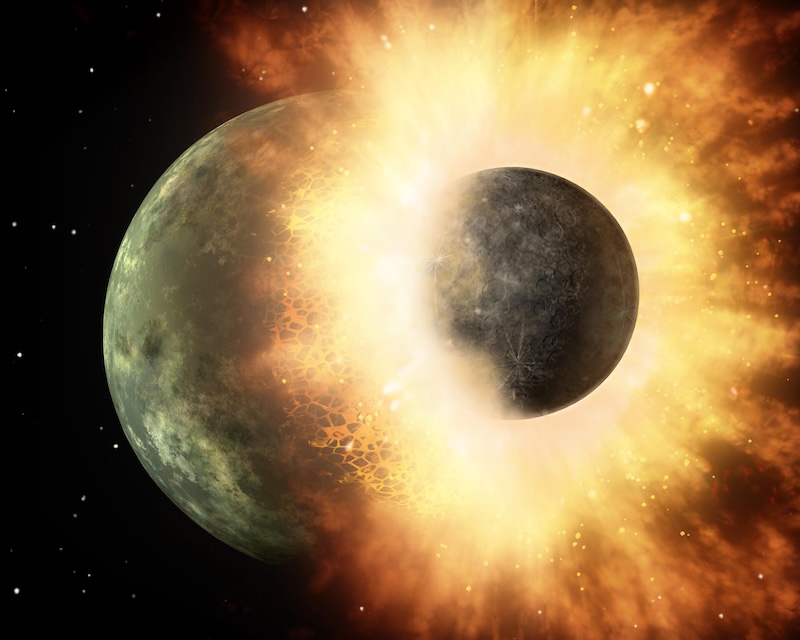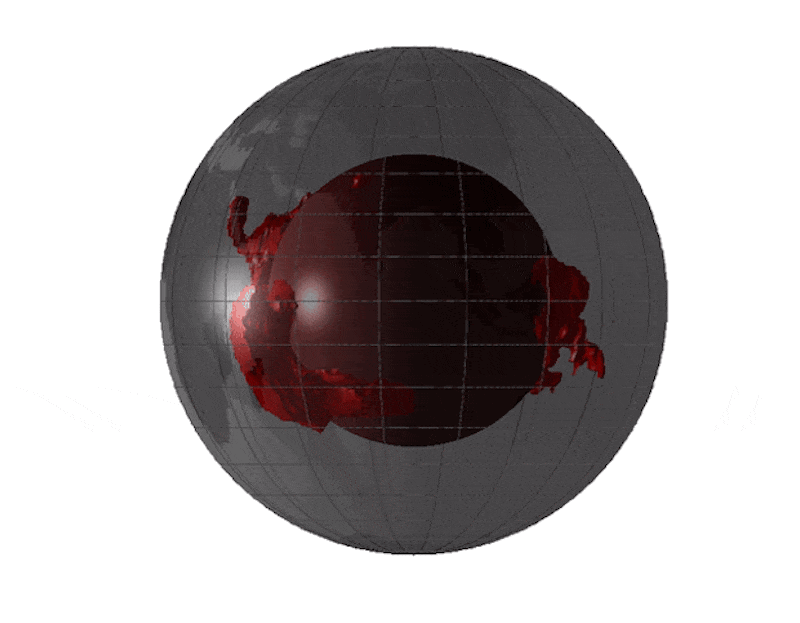
Did you know Earth has two large “blobs” inside it? One is beneath Africa and the other is below the Pacific Ocean. And they’re big, too, both about twice the size of Earth’s moon! They’re not part of our world’s mantle, the layer of silicate rock between Earth’s crust and outer core. They’re made of different elements than the mantle. So how did these great blobs inside Earth come to be? An international team of researchers said on November 1, 2023, that the blobs are likely left over from an ancient collision, which many scientists believe happened billions of years ago. That was when a young planet – called Theia (THAY-eh) by scientists – might have collided with the early Earth. According to this theory, this massive impact also created Earth’s moon.
Ed Garnero, at Arizona State University’s School of Earth and Space Exploration and one of the researchers involved with this study, said:
It appears that Earth’s blobs are remnants of a planetary collision that formed our moon. In other words, the massive blobs currently inside Earth, deep beneath our feet, are extraterrestrial. Earth not only has ‘blobs,’ Earth has extraterrestrial blobs!
The researchers, led by geophysicist Qian Yuan at Caltech in California, published their peer-reviewed findings on November 1, 2023.
The 2024 lunar calendars are here! Best Christmas gifts in the universe! Check ’em out here.
Unusual blobs inside Earth
Scientists have known about the two blobs for over 20 years. Geophysicists first discovered them in the 1980s. Their composition was different from the surrounding mantle. If you could somehow melt them and place them on the Earth’s surface, they would form a layer 60 miles (100 km) thick around our entire planet. That’s huge when you consider that the typical cruising altitude for most commercial airplanes is between about 6 and nearly 8 miles (10 and 12 km) above sea level.
So these blobs inside Earth are big. And scientists know they’re there, inside Earth. But where did they come from?
When Theia collided with Earth
The new study suggests that the blobs formed from the same collision that created our moon. That collision was with the hypothesized Theia, a young planet smaller than Earth. Scientists think that material from the impact formed into the moon. But what about the rest of Theia? Where did the rest of the material go?
Scientists have still not found any trace of it in meteorites or the asteroid belt. But now, the researchers behind the new study said that Earth probably absorbed most of Theia.
Steven Desch is a professor in the School of Earth and Space Exploration at Arizona State University. He said:
The moon appears to have materials within it representative of both the pre-impact Earth and Theia, but it was thought that any remnants of Theia in the Earth would have been ‘erased’ and homogenized by billions of years of dynamics (e.g., mantle convection) within the Earth. This is the first study to make the case that distinct ‘pieces’ of Theia still reside within the Earth, at its core-mantle boundary.
Seismic waves
Scientists first discovered the blobs – called large low-velocity provinces, or LLVPs – using seismic waves. Seismic waves are vibrations generated by an earthquake, explosion or other energetic source. The waves travel through the Earth, at different speeds and through different materials.
In the 1980s, studies of the seismic waves showed something unusual. There were large variations deep in the mantle. What was causing them? As it turned out, it was two structures – the two blobs – very deep below the surface, near the Earth’s core. They were hotter and denser than the surrounding mantle, and contained unusually high amounts of iron. And they were huge, the size of continents.
That’s how the blobs became known to scientists.
Extraterrestrial blobs
So the question became, how did they get there? And why are they made of such different materials from the rest of the mantle? The new study proposes an answer, after decades of research. They are remnants of Theia and the collision with Earth billions of years ago. The same collision gave birth to the moon.
This origin of the moon is called the giant impact hypothesis. Yuan had once attended a presentation about it by Mikhail Zolotov. Yuan suddenly realized that he might know where the blobs came from: Theia! No other trace of the impacting body had been found yet, and the moon is rich in iron. He said:
Right after Mikhail had said that no one knows where the impactor is now, I had a ‘eureka moment’ and realized that the iron-rich impactor could have transformed into mantle blobs.
So the remains of the impactor, Theia, were here all along, just deeply buried inside the Earth.

Moon and blobs inside Earth have same origin
Of course, Theia is long gone. And we can’t drill far enough into Earth to extract a piece of the blobs and measure their composition. But these researchers tested their ideas by modeling possible chemical compositions of Theia. The results supported the idea that the blobs came from Theia, according to Mingming Li at Arizona State University:
This work showed that the large blobs (the LLVPs) in Earth’s deep mantle may be made of materials from a planetary body that impacted the proto-Earth and formed the moon. Therefore, the moon and the blobs have the same origin.
Now here’s another question. Why did the material form into two larger blobs instead of mixing with the mantle? The researchers explained this puzzle by saying that most of the energy from the impact remained in the upper half of the mantle. Since the lower mantle didn’t melt, despite the incredibly violent impact, the material from Theia remained intact for the most part. Instead of mixing in with the mantle, it formed into the two large blobs.
The researchers also said the material from Theia would likely remain at the bottom of the mantle. As Li explained:
Through mantle convection simulations, we found that the dense, iron-rich materials from Theia could sink to and accumulate at the base of Earth’s mantle. These materials could stay there throughout Earth’s history of about 4.5 billion years.
More evidence for moon-forming impact
So this study helps explain how the blobs inside Earth got there. The study also provides more evidence for the impact origin of the moon. Co-author Travis Gabriel at the U.S. Geological Survey said:
By looking inward, toward Earth’s interior, instead of outward, toward the moon, we have found yet another piece of evidence of the cosmic catastrophe that is the moon-forming giant impact.
A NASA study in 2022 also showed that the moon might have formed incredibly fast, in only a matter of hours. Wow!
Prior to our time, the origin of our moon was long debated. But modern scientists mostly agree it appears our moon formed as a result of a giant impact between Earth and another smaller rocky planet, Theia. Now it seems that collision left behind evidence, in the form of the two blobs inside Earth.
Those blobs have been mysterious since their discovery decades ago. Now they’re helping scientists solve another great mystery: the origin of our moon.
Bottom line: A new study from an international team of researchers says that two huge blobs inside Earth came from the collision with the planet Theia billions of years ago.
Source: Moon-forming impactor as a source of Earth’s basal mantle anomalies
Read more: Moon formed from Earth collision with planet-sized body: New evidence











